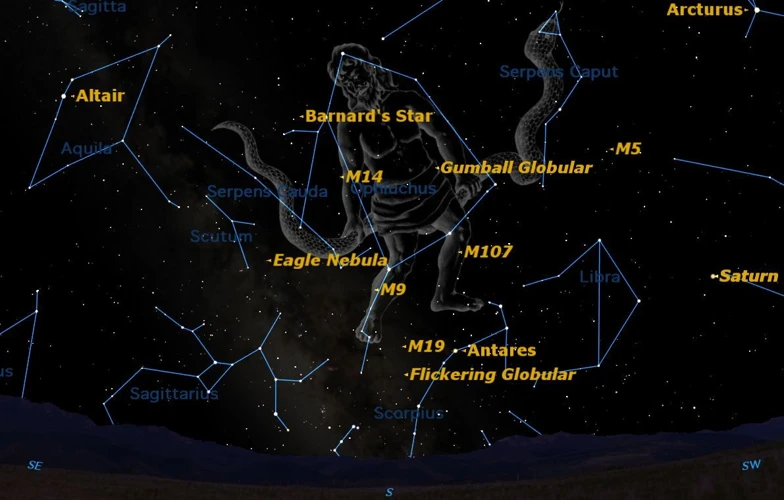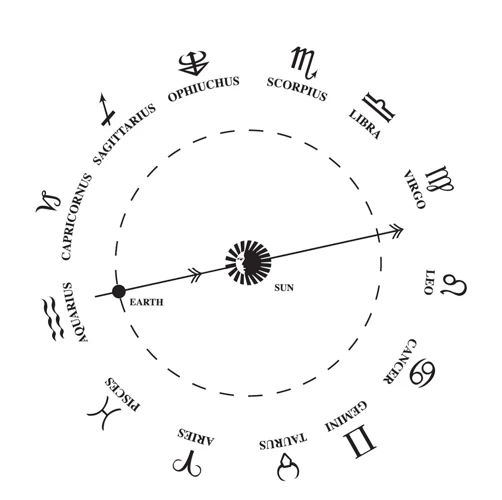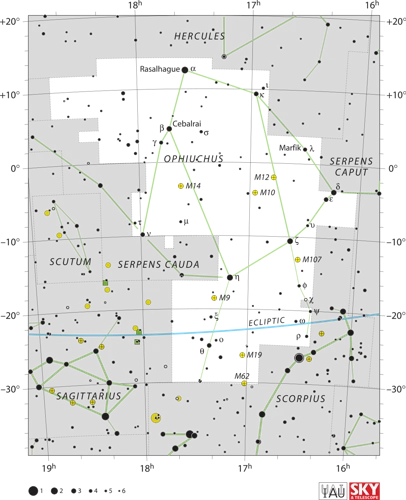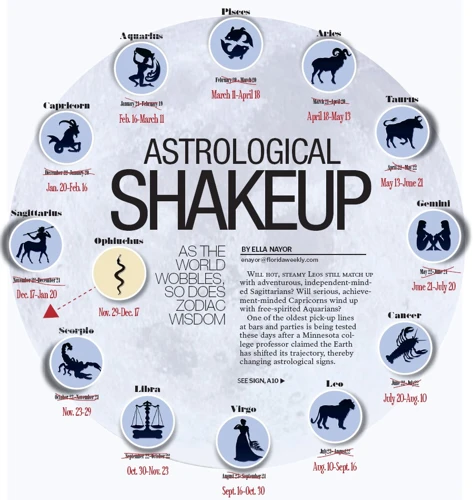Astrology has been a subject of fascination for centuries, with its ability to provide insights into our personalities, relationships, and even our futures. But have you ever wondered how astrology aligns with the actual constellations in the sky? The science behind the zodiac constellations and their connection to astrology is a complex and intriguing topic. In this article, we will explore the historical origins of astrology, the twelve zodiac constellations, and delve into the scientific explanations behind the alignment of the zodiac with astrological predictions. So, if you’re curious about the intersection of science and mysticism, buckle up, and prepare to uncover the mysteries of the zodiac constellations and their relationship to astrology.
Contents
- Understanding Astrology
- The Zodiac Constellations
- Astrology and Zodiac Alignment
- The Science Behind Alignment
- The Debate: Astrology vs Science
- Conclusion
-
Frequently Asked Questions
- 1. What role do the zodiac constellations play in astrology?
- 2. How many zodiac constellations are there?
- 3. Do the zodiac constellations align with the current astronomical positions?
- 4. How does the precession of the equinoxes affect astrology?
- 5. Can someone’s zodiac sign change due to the precession of the equinoxes?
- 6. How does astrology explain compatibility between zodiac signs?
- 7. Are there scientific studies that support astrology?
- 8. Can astrology predict specific events or outcomes in a person’s life?
- 9. Is astrology culturally universal or specific to certain traditions?
- 10. Can astrology be used as a tool for self-reflection and personal growth?
- References
-
Frequently Asked Questions
- 1. How do zodiac constellations align with astrology?
- 2. What is the difference between astrology and astronomy?
- 3. How were the zodiac constellations named?
- 4. Can zodiac constellations change over time?
- 5. What is the significance of the precession of the equinoxes?
- 6. Do zodiac constellations align with sun signs?
- 7. How does the Earth’s tilt affect zodiac alignment?
- 8. What is stellar parallax and its connection to zodiac constellations?
- 9. How does astrological zodiac differ from the astronomical zodiac?
- 10. What are some criticisms of astrology?
- References
- Read More
Understanding Astrology

Astrology, a practice with roots in ancient civilizations, holds a myriad of interpretations and beliefs. What is Astrology? Astrology is the study of celestial bodies’ positions and their influence on human behavior and events. It examines the correlation between the movements and alignments of planets, stars, and constellations and the potential impact on individuals’ lives. The Origins of Astrology can be traced back thousands of years to Mesopotamia, Egypt, and ancient Greece. These ancient civilizations developed complex systems to understand celestial patterns and their impact on human affairs. The Egyptians, for example, associated specific constellations with their mythological gods and goddesses, which shaped their beliefs about life and the afterlife. Understanding the origins of astrology provides valuable context for comprehending its significance in different cultures throughout history. Ancient Egyptian creation myths tied closely to the celestial world, demonstrating the interplay between human life and the cosmos. Astrology continues to captivate the world today, with many seeking guidance and insights from astrological readings and horoscopes. Whether you’re a skeptic or a believer, astrology’s influence on society is undeniable, and delving into its origins and principles can offer a more nuanced perspective on this ancient practice
1.1 What is Astrology?
Astrology is a complex and ancient practice that seeks to understand the correlation between celestial bodies and human behavior. What is Astrology? Astrology is the study of the positions and alignments of celestial bodies, such as planets, stars, and constellations, and how they may influence various aspects of human life. It is based on the belief that there is a connection between the positions and movements of these celestial bodies and the events occurring on Earth. Astrology encompasses a wide range of techniques and systems, including horoscopes, birth charts, and compatibility readings.
Astrologers believe that each celestial body in the sky represents a different aspect of human existence, such as personality traits, emotions, relationships, and even future events. By analyzing the positions of these celestial bodies at the time of a person’s birth or during a specific event, astrologers can make predictions and offer insights into various areas of life. These predictions are often made through the interpretation of zodiac signs, which are twelve specific constellations that are traditionally associated with different personality traits and characteristics.
It’s important to note that astrology is not considered a science in the traditional sense. While it has ancient roots and a rich history, astrology relies on subjective interpretations and beliefs rather than empirical evidence. Despite the lack of scientific validation, astrology continues to have a significant impact on many cultures worldwide, with millions of people turning to it for guidance and self-discovery. Whether you view astrology as a tool for self-reflection or find it intriguing from a historical and cultural perspective, exploring its origins and principles can provide a deeper understanding of this fascinating practice.
1.2 The Origins of Astrology
The origins of astrology can be traced back to ancient civilizations such as Mesopotamia, Egypt, and ancient Greece. These early cultures developed intricate systems to make sense of celestial patterns and their relationship to human life. In Mesopotamia, astrologers observed celestial events and associated them with significant events on Earth. They believed that the movements of celestial bodies held deep meaning and could provide insights into the future. The Egyptians, on the other hand, tied astrology closely to their mythological beliefs. They associated specific constellations with their gods and goddesses, attributing unique qualities and powers to each. This formed the basis for astrological interpretations and horoscope readings. Greek philosophers and scholars further developed astrology, introducing concepts such as the zodiac and connecting celestial phenomena to individual personalities. These ancient practices and ideas have had a profound influence on modern astrology. Today, millions of people around the world still turn to astrology to gain insight into their lives, relationships, and future events. The connection between ancient constellations and modern astronomy continues to intrigue researchers, allowing for new discoveries and a deeper understanding of our cosmic surroundings. The influence of ancient constellations on modern astronomy sheds light on the rich history and significance of these celestial formations. Exploring the origins of astrology offers a glimpse into the ways in which ancient cultures intertwined the celestial and human realms, creating a belief system that continues to captivate and inspire us today.
The Zodiac Constellations

The Zodiac is a fascinating concept that revolves around twelve Zodiac Constellations. These constellations form a belt around the celestial sphere and have been observed and studied for centuries. Introduction to the Zodiac reveals that each constellation is associated with specific dates and astrological signs, offering unique characteristics and traits to individuals born under their influence. The twelve Zodiac Constellations include Aries, Taurus, Gemini, Cancer, Leo, Virgo, Libra, Scorpio, Sagittarius, Capricorn, Aquarius, and Pisces. Each constellation possesses its distinct mythology, symbolism, and qualities that are often connected to astrological interpretations. For instance, those born under the Sagittarius sign are known for their adventurous and optimistic traits. Exploring the adventurous and optimistic traits of Sagittarius can deepen our understanding of how the Zodiac constellations influence astrological readings and personality assessments. Whether you are a believer or a skeptic, exploring the Zodiac constellations can offer a unique perspective on the fascinating intersection between astronomy and astrology.
2.1 Introduction to the Zodiac
The Zodiac is an integral part of astrology and is often associated with our horoscopes and personality traits. But what exactly is the Zodiac? In astrology, the Zodiac is a band divided into twelve equal sections, each corresponding to a specific constellation. These constellations are symbolic representations of various animals, objects, and figures. Each section, or sign, of the Zodiac is believed to influence different aspects of a person’s life and personality.
The Zodiac is thought to have originated from ancient civilizations’ observations of the night sky and their connection between celestial bodies and human behavior. The twelve signs of the Zodiac are Aries, Taurus, Gemini, Cancer, Leo, Virgo, Libra, Scorpio, Sagittarius, Capricorn, Aquarius, and Pisces. Each sign spans a particular date range, with slight variations due to the alignment of the Earth and the Sun.
Each Zodiac sign is associated with specific qualities and elements. Aries, for example, is known for being independent and adventurous, while Taurus is associated with stability and practicality. Gemini represents curiosity and adaptability, while Cancer embodies nurturing and emotional sensitivity. These associations help people identify their dominant personality traits and provide insight into compatibility with others.
It’s important to note that the Zodiac is not fixed in the night sky but is instead a symbolic representation based on Earth’s alignment with the Sun and the constellations at a given time. This alignment creates the foundation for astrological predictions and interpretations. Understanding the Zodiac’s introductory concepts allows us to explore how these constellations align with astrology and form the basis for interpreting our horoscopes and understanding ourselves on a deeper level.
2.2 The Twelve Zodiac Constellations
The twelve zodiac constellations play a significant role in astrology, as they provide the framework for understanding personality traits and making predictions. These constellations are clusters of stars that form distinctive patterns in the night sky. Each zodiac constellation is associated with a specific astrological sign, representing a particular period of the year. These signs are Aries, Taurus, Gemini, Cancer, Leo, Virgo, Libra, Scorpio, Sagittarius, Capricorn, Aquarius, and Pisces. Each zodiac sign has its own unique characteristics, influenced by the constellation it is associated with.
Aries, represented by the Ram, is known to be passionate and independent, while Taurus, represented by the Bull, is associated with stability and determination. Gemini, portrayed as the Twins, signifies adaptability and intellectual curiosity, while Cancer, represented by the Crab, embodies emotional sensitivity and nurturing qualities. Leo, depicted as the Lion, is associated with leadership and confidence, while Virgo, represented by the Maiden, is characterized by practicality and attention to detail.
The scales of Libra signify balance and harmony, while the mysterious Scorpio is associated with intensity and transformation. Sagittarius, depicted as the Archer, embodies adventure and optimism, while disciplined and ambitious qualities are attributed to Capricorn, represented by the Goat. Aquarius, symbolized by the Water Bearer, represents innovation and humanitarianism, while Pisces, represented by the Fish, is known for its compassion and intuition.
These twelve zodiac constellations serve as valuable tools in astrology, assisting astrologers in interpreting an individual’s personality traits, relationships, and life events based on the position of the stars at the time of their birth. Exploring the characteristics and symbolism associated with each zodiac constellation can provide a deeper understanding of astrology and its influence on human lives. For more information on specific zodiac signs and their traits, you can refer to articles such as “Exploring Sagittarius: Adventurous and Optimistic Traits”, which delves into the qualities of one particular zodiac sign.
Astrology and Zodiac Alignment

Astrology and Zodiac Alignment go hand in hand, as the zodiac signs play a pivotal role in astrological predictions. The Historical Alignment of the zodiac signs with specific constellations dates back to ancient civilizations, who observed the celestial patterns and associated them with certain human characteristics. The twelve zodiac signs, such as Aries, Taurus, Gemini, and so on, are believed to represent distinct personality traits and behaviors. However, there is a celestial phenomenon called The Precession of the Equinoxes, which has caused a shift in the alignment of the zodiac constellations over time. This means that the zodiac signs no longer align perfectly with the original constellations. Despite this shift, many astrologers still rely on the traditional alignment to provide astrological interpretations for individuals. It’s important to note that the zodiac constellations do not align with sun signs, which represent the position of the Sun at the time of one’s birth. This distinction between the zodiac constellations and sun signs adds another layer of complexity to the relationship between astrology and zodiac alignment. Exploring the historical and scientific aspects of this alignment can shed light on the intricacies of astrology and how it relates to the celestial world.
3.1 The Historical Alignment
The historical alignment between zodiac constellations and astrology is a subject of great interest and intrigue. The Historical Alignment refers to the correlation between the traditional zodiac signs and the actual position of the constellations in the sky. The zodiac signs are based on the division of the ecliptic into twelve equal parts, with each part representing a specific constellation. However, over time, the Earth’s axial precession has caused a shift in the positions of the constellations. This means that the zodiac signs we associate with specific dates no longer align exactly with the constellations after which they are named. For example, the sign of Aries is traditionally associated with the constellation Aries, but due to precession, the Sun is now in front of Pisces during the period that was once designated as Aries. This misalignment has raised questions about the accuracy and validity of astrological predictions based on the zodiac signs. Nevertheless, astrology continues to be practiced and celebrated, with many interpreting the zodiac signs symbolically rather than relying solely on their astronomical alignment. Understanding the historical alignment sheds light on the evolving nature of astrology and encourages a critical examination of its principles.
3.2 The Precession of the Equinoxes
The Precession of the Equinoxes is a fascinating astronomical phenomenon that plays a crucial role in the alignment of zodiac constellations with astrology. The Earth’s axis, which is responsible for the change in seasons, also undergoes a slow, steady wobble over the course of approximately 26,000 years. This wobbling motion is known as the precession, and it causes a gradual shift in the alignment of the Earth’s axis with the stars. As a result, the positions of the zodiac constellations that were once aligned with the corresponding astrological signs gradually change over time. For example, if you were born under the sign of Aries, traditionally associated with the constellation of the same name, due to the precession, you would actually be born under the constellation Pisces in the present era. This shift in the alignment is caused by the gravitational interactions between the Earth, Moon, and Sun. It is important to note that astrological predictions are still based on the traditional alignment of the zodiac signs, rather than the current astronomical position of the constellations. Understanding the precession of the equinoxes provides a scientific explanation for the shifting positions of the zodiac constellations, highlighting the dynamic nature of astrology and its connection to the ever-changing cosmos.
3.3 Zodiac Constellations vs Sun Signs
One common misconception in astrology is the confusion between zodiac constellations and sun signs. While they are related, they are not the same thing. The distinction lies in the fact that zodiac constellations refer to the actual star patterns in the sky, while sun signs are determined by the position of the sun at the time of a person’s birth.
In astrology, the zodiac is divided into twelve equal parts, each associated with a specific constellation. These constellations, such as Aries, Taurus, Gemini, etc., serve as reference points in the sky. However, due to the Earth’s axial precession, the alignment between the zodiac constellations and the sun signs has shifted over time.
Here is a comparison between the zodiac constellations and sun signs:
Zodiac Constellations:
1. Consist of twelve star patterns in the sky.
2. Each constellation occupies a specific position in the sky at a given time.
3. Ancient astronomers used these constellations as a reference system to track celestial movements.
4. The constellations themselves are fixed.
Sun Signs:
1. Determined by the position of the sun at the time of a person’s birth.
2. Associated with specific dates of the year, representing the period when the sun passes through a particular zodiac constellation.
3. Often used in horoscopes and astrological predictions to provide insights into an individual’s personality traits and potential life experiences.
4. The dates corresponding to each sun sign are consistent year after year.
Zodiac constellations are the actual star patterns in the sky, while sun signs are the astrological interpretations based on the position of the sun at the time of a person’s birth. While the two are connected, they are distinct concepts in astrology. So, next time you read your horoscope based on your sun sign, remember that it represents a symbolic interpretation of the zodiac rather than a direct correlation with the physical constellations in the sky.
The Science Behind Alignment

The alignment of the zodiac constellations with astrology may seem mysterious, but there is actually a scientific explanation behind it. The Earth’s Tilt and Zodiac Alignment play a crucial role in this phenomenon. Earth’s axis is tilted relative to its orbit, resulting in the changing of the seasons. This tilt also affects the positions of the stars and constellations in the night sky. As the Earth orbits the Sun, different constellations come into view at different times of the year, causing their alignment with specific astrological signs. Another factor at play is Stellar Parallax and Zodiac Constellations. Stellar parallax is the apparent shift in the position of a star when observed from different points in Earth’s orbit. This allows astronomers to measure the distance to nearby stars. However, for zodiac constellations, which are much farther away, the parallax shift is negligible. This means that, from our perspective on Earth, the zodiac constellations remain relatively fixed, aligning with the same astrological signs as they have for centuries. It is important to note that there is a distinction between the Astrological Zodiac and the Astronomical Zodiac. While astrology follows the constellations of the zodiac, astronomers define zodiacal constellations based on the positions of the Sun throughout the year. Understanding the science behind the alignment of the zodiac constellations provides a deeper appreciation for the interconnectedness of astrology, astronomy, and the natural world.
4.1 The Earth’s Tilt and Zodiac Alignment
The alignment of the zodiac constellations with astrology is intricately linked to the Earth’s tilt. The Earth’s axis is tilted at an angle of approximately 23.5 degrees in relation to its orbit around the Sun. This tilt is responsible for the changing seasons we experience throughout the year. But how does this tilt affect the alignment of the zodiac constellations? The answer lies in the Earth’s annual journey around the Sun.
As the Earth orbits the Sun, different constellations appear in the night sky at different times of the year. This phenomenon occurs because of the Earth’s tilt and its position in relation to the Sun. For example, during the spring equinox in the Northern Hemisphere, when the Sun crosses the celestial equator, the zodiac constellation Aries is said to be in alignment with the Sun. Similarly, during the winter solstice, when the Sun reaches its lowest point in the sky, the zodiac constellation Capricorn is believed to align with the Sun.
It is important to note that the alignment of the zodiac constellations with astrology is based on a geocentric perspective, where Earth is seen as the center of the universe. From this vantage point, the zodiac constellations appear to move across the sky as the Earth rotates and orbits the Sun. This movement creates the illusion that the Sun is passing through different zodiac constellations throughout the year, giving rise to the concept of Sun signs in astrology.
However, from an astronomical perspective, the constellations themselves do not change position relative to one another. It is the Earth’s motion that causes the apparent shift in the Sun’s position against the background of fixed stars. This misalignment between the astrological zodiac and the actual position of the constellations is known as the Precession of the Equinoxes, which will be explored further in the next section.
Understanding the Earth’s tilt and its impact on the alignment of zodiac constellations provides insight into the intricate relationship between astrology and astronomy. While the zodiac constellations do not directly determine an individual’s astrological sign, their positions within the sky play a significant role in astrological interpretations. It is through the lens of the Earth’s tilt and the changing seasons that astrology finds its basis in the alignment of the zodiac constellations with the Sun’s apparent path across the celestial sphere.
4.2 Stellar Parallax and Zodiac Constellations
Stellar parallax is a phenomenon that plays a significant role in understanding the alignment of zodiac constellations. It refers to the apparent shift in the position of a star as observed from different vantage points on Earth. This shift occurs due to the Earth’s orbit around the Sun, causing stars to appear in slightly different positions over time. The concept of stellar parallax allows astronomers to measure the distance of stars from Earth, enabling a more accurate understanding of celestial objects and their relation to the zodiac constellations.
In the context of astrology, stellar parallax raises interesting questions. While astrologers associate specific zodiac constellations with the dates of birth, the actual positions of the constellations have shifted over millennia due to the Earth’s precession. This raises concerns about the accuracy of astrological interpretations based solely on the position of the zodiac constellations at specific times.
For instance, if someone is born under the sign of Aries, astrologers traditionally associate their personality traits and life events with the constellation of Aries. However, due to stellar parallax and the Earth’s precession, the constellation Aries is no longer in the same position in the night sky as it was during ancient times. The discrepancy between the astrological belief system and the actual positions of the constellations presents a challenge for those seeking a scientific understanding of astrology. It calls into question the validity of astrological predictions solely based on the positions of the zodiac constellations.
The movements caused by stellar parallax also have implications for the concept of astrological cusps. Cusps occur when someone’s birthday falls on the transition between two zodiac signs, leading to a blending of characteristics associated with both signs. However, with the shifting positions of the constellations, the idea of cusps becomes more complicated. The exact transition points between signs can vary depending on the chosen zodiac system (such as tropical or sidereal), further adding to the uncertainty surrounding cusps.
It is important to note that while there is scientific evidence supporting stellar parallax, the debate between astrology and science concerning the interpretation and significance of zodiac constellations continues. While astronomy focuses on the physical aspects of celestial bodies and their movements, astrology interprets these movements as symbolic influences on human lives. This ongoing debate emphasizes the distinction between astronomy as a science and astrology as a belief system.
4.3 Astrological Zodiac vs Astronomical Zodiac
Astrological Zodiac and Astronomical Zodiac are two terms often used interchangeably, but they have distinct differences in their meanings and applications. The Astrological Zodiac is based on the concept of dividing the ecliptic (the apparent path of the Sun around the Earth) into twelve equal parts, each associated with a specific zodiac sign. These signs, such as Aries, Taurus, and Gemini, are traditionally linked to personality traits and characteristics assigned to individuals based on their birth dates. Astrologers believe that the positions of the planets and their relationships with these zodiac signs at the time of birth influence a person’s personality and destiny.
On the other hand, the Astronomical Zodiac refers to the actual positions of the constellations in the sky. It is based on the fixed star patterns observed by astronomers and their scientific classification. Unlike the Astrological Zodiac, which divides the ecliptic into twelve equal parts, the Astronomical Zodiac recognizes that the constellations vary in size and shape.
Over centuries, the positions of the constellations have shifted due to a phenomenon called the Precession of the Equinoxes. This gradual shift is caused by the Earth’s wobbling on its axis, resulting in a slight movement of the stars over long periods of time. As a result, the dates associated with each zodiac sign in the Astrological Zodiac no longer align with the actual positions of the constellations in the Astronomical Zodiac.
For example, while someone born on April 1st may be considered an Aries in the Astrological Zodiac, the Sun is actually in the constellation of Pisces during that time due to the shifting of the constellations. This misalignment between the Astrological Zodiac and the Astronomical Zodiac has led to debates and discrepancies between astrologers and astronomers.
It’s important to note that both the Astrological Zodiac and the Astronomical Zodiac hold significance in their respective fields. Astrology focuses on the interpretation of celestial influences on individual lives, while astronomy studies the physical properties and movements of celestial objects. The disconnect between the two zodiac systems highlights the distinct ways in which astrology and astronomy approach the study of the cosmos.
The Astrological Zodiac and the Astronomical Zodiac may share the same names, but their meanings and interpretations differ. The Astrological Zodiac pertains to the twelve signs associated with personality traits, while the Astronomical Zodiac refers to the actual positions of the constellations in the sky. The misalignment between the two zodiac systems, caused by the Precession of the Equinoxes, has given rise to ongoing debates and discussions about the validity and accuracy of astrological predictions based on constellations.
The Debate: Astrology vs Science

The debate between astrology and science has been ongoing for decades, pitting the ancient art of astrology against the rigorous methods of scientific inquiry. Criticisms of Astrology from the scientific community revolve around the lack of empirical evidence and reproducible results. Skeptics argue that astrology relies on vague and generalized predictions that can apply to anyone, leading to subjective interpretations. Additionally, scientific studies examining the validity of astrology have produced mixed results, with some showing no correlation between astrological predictions and real-life outcomes. However, scientific studies on astrology have also sparked intriguing discussions. Some studies have suggested potential relationships between celestial bodies and human behavior, although the mechanisms remain elusive. As the debate rages on, it is important to consider that astrology and science operate on different principles. While science demands evidence and testability, astrology offers a unique lens through which individuals derive personal meaning and introspection. The debate between astrology and science reflects the complexity of understanding the mysteries of the universe and the diverse ways individuals seek answers and find meaning in their lives.
5.1 Criticisms of Astrology
Astrology, like any field of study or practice, has not been immune to criticism. Criticisms of Astrology encompass a wide range of arguments and skepticism. One common criticism is that astrology lacks scientific evidence to support its claims. Skeptics argue that the positioning of celestial bodies at the time of birth cannot possibly have a direct influence on an individual’s personality, traits, or destiny. They suggest that astrology’s perceived accuracy is often a result of subjective validation or the Barnum effect, where general statements are interpreted as personal and specific. Another criticism is that astrological predictions are often vague and open to interpretation, making it difficult to evaluate their accuracy objectively. Critics also question the validity of the astrological system itself, arguing that it fails to account for the influence of other factors such as upbringing, culture, and personal experiences. Additionally, the concept of the precession of the equinoxes poses a challenge to astrology, as the alignment of the zodiac signs has shifted over centuries. Some argue that this misalignment invalidates astrological predictions based on the traditional zodiac signs. While astrology may have its share of skeptics, it continues to fascinate and resonate with many individuals who find meaning and guidance in its teachings.
5.2 Scientific Studies on Astrology
Scientific studies on astrology have been the subject of much debate and scrutiny. While astrology is often considered a pseudoscience, there have been efforts to examine its validity through empirical research. In these Scientific Studies on Astrology, researchers have explored various aspects of astrology, aiming to determine if there is any scientific basis to its claims.
One well-known study, conducted by French psychologist Michel Gauquelin in the mid-20th century, focused on the correlation between the positions of celestial bodies and certain personality traits. Gauquelin’s research suggested a potential connection between the placement of Mars in the birth chart and professions in sports, but his findings have garnered criticism for methodological issues and statistical anomalies.
Another study, published in the journal “Nature” in 1985, examined the relationship between astrological birth charts and marriage compatibility. The researchers analyzed the birth data of thousands of married couples and found no significant correlation between astrological compatibility and the success of their marriages.
A meta-analysis published in the journal “Psychological Reports” in 2000 aimed to determine if there was any evidence to support astrology’s claims. The analysis reviewed over 40 studies and concluded that the scientific evidence did not support the validity of astrology as a predictive tool.
While these scientific studies on astrology have failed to provide substantial evidence for its accuracy, it is important to note that astrology continues to have a strong cultural and personal significance for many individuals. The appeal of astrology lies in its ability to offer guidance, insight, and a sense of self-awareness. While astrology may not have a solid scientific foundation, its impact on individuals’ lives should not be dismissed.
Conclusion

In , the science of zodiac constellations and their alignment with astrology is a fascinating and complex subject. While astrology has its roots in ancient civilizations and has been a source of guidance and fascination for many, it has also faced criticism and skepticism from the scientific community. The alignment of zodiac constellations with astrological predictions raises questions about the extent to which these celestial bodies truly influence our lives.
From a scientific perspective, it is essential to differentiate between astrological zodiac signs and astronomical constellations. While astrology relies on the position of the sun in the zodiac at the time of birth, the actual constellations have shifted over time due to the Earth’s axial tilt and the precession of the equinoxes. This misalignment leads to discrepancies between the astrological zodiac and the actual position of the constellations.
The debate between astrology and science continues to persist. Critics argue that astrology lacks empirical evidence and relies on subjective interpretations, making it difficult to prove or disprove its claims. Scientific studies on astrology often fail to provide conclusive evidence supporting its validity.
However, it is worth noting that astrology has cultural, psychological, and symbolic significance for many individuals. For some, it serves as a tool for introspection, self-discovery, and personal growth. It can provide a sense of comfort and guidance during uncertain times. Ultimately, the value and belief in astrology lie in the eye of the beholder.
In conclusion, the science behind zodiac constellations and their alignment with astrology presents a complex interplay between ancient beliefs, celestial movements, and personal interpretations. While scientific evidence may not fully support the claims of astrology, its enduring popularity and cultural significance cannot be ignored. Whether you choose to embrace astrology as a guiding force or view it skeptically, it remains an intriguing subject worthy of exploration.
| Pros | Cons |
|---|---|
| 1. Provides introspection and self-reflection | 1. Lacks empirical evidence |
| 2. Offers comfort and guidance | 2. Subjective interpretations |
| 3. Cultural and symbolic significance | 3. Alignment discrepancies between astrological zodiacs and actual constellations |
Frequently Asked Questions

1. What role do the zodiac constellations play in astrology?
The zodiac constellations serve as a symbolic framework in astrology. Each constellation represents a specific personality archetype and is associated with certain traits and characteristics.
2. How many zodiac constellations are there?
There are twelve zodiac constellations: Aries, Taurus, Gemini, Cancer, Leo, Virgo, Libra, Scorpio, Sagittarius, Capricorn, Aquarius, and Pisces. These constellations form a circular path in the sky known as the ecliptic.
3. Do the zodiac constellations align with the current astronomical positions?
No, the zodiac constellations do not align with the current astronomical positions. Due to the phenomenon called the precession of the equinoxes, there is a slight shift in the alignment over time.
4. How does the precession of the equinoxes affect astrology?
The precession of the equinoxes causes a shift in the astrological ages, which impacts the interpretation of zodiac signs. It means that the dates associated with each zodiac sign have changed over the centuries.
5. Can someone’s zodiac sign change due to the precession of the equinoxes?
No, the precession of the equinoxes does not change an individual’s zodiac sign. The zodiac sign is determined by the position of the Sun at the time of birth, which remains constant regardless of the precession.
6. How does astrology explain compatibility between zodiac signs?
Astrology suggests that the alignment of certain zodiac signs creates harmony or tension in relationships. Compatibility is determined by the interaction of elements, such as fire, earth, air, and water, associated with each zodiac sign.
7. Are there scientific studies that support astrology?
While there have been some scientific studies exploring astrology, overall, the scientific community largely dismisses astrology as a pseudoscience due to a lack of empirical evidence.
8. Can astrology predict specific events or outcomes in a person’s life?
Astrology focuses more on general patterns and tendencies rather than specific events or outcomes. It can offer insights into potential influences, but it does not provide a guarantee of specific events occurring.
9. Is astrology culturally universal or specific to certain traditions?
Astrology exists in various forms across different cultures and traditions. While there are similarities in the concepts, interpretations, and symbolism may vary based on cultural and historical contexts.
10. Can astrology be used as a tool for self-reflection and personal growth?
Astrology can be used as a tool for self-reflection and personal growth. By exploring the characteristics associated with their zodiac sign, individuals may gain insights into their strengths, weaknesses, and potential areas for development.
References
Frequently Asked Questions

1. How do zodiac constellations align with astrology?
Zodiac constellations serve as a basis for astrology, providing a framework to interpret celestial influences on human behavior and personality traits.
2. What is the difference between astrology and astronomy?
Astrology is the study of the influence of celestial bodies on human affairs, while astronomy is the scientific study of celestial objects and phenomena.
3. How were the zodiac constellations named?
The names of the zodiac constellations were inspired by ancient Greek mythology, aligning with various stories and figures from their culture.
4. Can zodiac constellations change over time?
Zodiac constellations are a fixed group of stars and do not change over time. However, their positions relative to Earth may shift due to the phenomenon known as precession.
5. What is the significance of the precession of the equinoxes?
The precession of the equinoxes is the gradual shift in the Earth’s rotational axis, which affects the alignment of zodiac constellations with the seasons and the astrological calendar.
6. Do zodiac constellations align with sun signs?
While zodiac constellations and sun signs are related, they are not the same. Sun signs are determined by the position of the Sun at the time of birth, while zodiac constellations refer to the patterns of stars in the sky.
7. How does the Earth’s tilt affect zodiac alignment?
The Earth’s tilt plays a crucial role in zodiac alignment by causing the Sun’s apparent path through the sky to change over the course of a year, leading to the changing of seasons and the movement of zodiac constellations.
8. What is stellar parallax and its connection to zodiac constellations?
Stellar parallax is the apparent shift in the position of a star due to the Earth’s orbit around the Sun. While stellar parallax is not directly related to zodiac constellations, its measurement helps determine the distance between stars.
9. How does astrological zodiac differ from the astronomical zodiac?
Astrological zodiac refers to the zodiac signs used in astrology, where the calendar is divided into twelve equal parts. In contrast, the astronomical zodiac is based on the actual positions of the constellations in the sky.
10. What are some criticisms of astrology?
Critics of astrology argue that it lacks scientific evidence, relies on subjective interpretations, and fails to account for individual differences within each zodiac sign.







